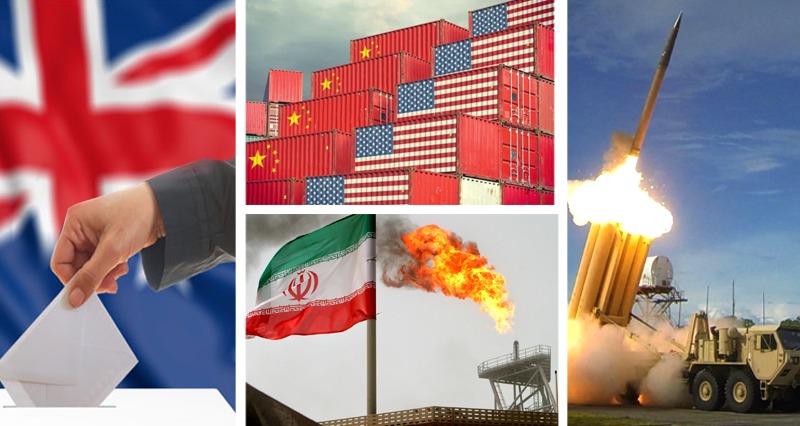Is the US mobilizing the armed forces against Iran?
The situation in the Persian Gulf heated up dramatically this week. The United States has increased its military presence in the region and advised their citizens in Arab countries to remain vigilant.
On the 6th of May, the US sent a naval strike group (the aircraft carrier USS ‘Abraham Lincoln’ and a fleet of bombers) to Iranian maritime borders, the zone of operational responsibility of the US Central Command (CENTCOM). One week later, acting Defense Secretary Patrick Shanahan presented an updated military plan to US President Donald Trump that envisions sending as many as 120,000 troops to the Middle East to neutralize the threat from Iran.
As The New York Times reported, this military plan could be implemented if ‘Iran attacks the American forces or accelerates work on nuclear weapons’. The authors of this article emphasized that there is no talk about the direct invasion of Iran, ‘which would require vastly more troops’.
The White House is reviewing military plans against Iran — including sending as many as 120,000 troops to the Middle East — in echoes of the Iraq war https://t.co/Dxy6jFGId2
— The New York Times (@nytimes) May 14, 2019
Information about the huge mobilization of US troops for war with Iran shocked the international community, as it could result in the most brutal and long term war the United States has engaged in in the Middle East. However, 24 hours had not yet elapsed before the Trump made an important statement de-escalating the situation, telling Acting Defense Secretary Patrick Shanahan that he didn’t want a war with Iran.
Breaking News: President Trump told the acting defense secretary that he didn’t want a war with Iran, officials said, even as some aides were stoking tensions. https://t.co/ZpOO1XFNMh
— The New York Times (@nytimes) May 16, 2019
The president also posted tweets accusing American media outlets of publishing fake news and cheating the international audience.
The Fake News Washington Post, and even more Fake News New York Times, are writing stories that there is infighting with respect to my strong policy in the Middle East. There is no infighting whatsoever….
— Donald J. Trump (@realDonaldTrump) May 15, 2019
Still, Trump’s statements at times seemed almost contradictory, as he also stated: ‘Now, would I do that? Absolutely. But we have not planned for that. Hopefully we’re not going to have to plan for that. And if we did that, we’d send a hell of a lot more troops than that’.
Despite the statement, the US Armed Forces don’t want to leave the Persian Gulf and send new warships to the Iranian border.
The US Naval Institute (USNI) reported that two U.S. guided-missile destroyers entered the Persian Gulf on Thursday without incident as the likelihood of an armed confrontation between Iran and the U.S. began to appear less likely.
BREAKING: Two U.S. Warships Enter Persian Gulf Without Incident – USNI Newshttps://t.co/IEQx8uTwdR pic.twitter.com/aOkOliwWrq
— USNI News (@USNINews) May 16, 2019
According to a USNI report, the USS McFaul (DDG-74) and USS Gonzalez (DDG-66) transferred through the Strait of Hormuz without challenge from Iran’s Islamic Revolution Guards Corps Navy (IRGCN). Each of these warships is capable of carrying 90 Tomahawk missiles.
The Abraham Lincoln Carrier Strike Group was operating off the coast of Oman while the USS Kearsarge (LHD-3) was off the coast of the United Arab Emirates near the entrance to the Persian Gulf. The USS Kearsarge is able to carry 20-30 aircraft and helicopters, including the fifth-generation combat aircraft (F-35B).
Trade war between China and the US
On May 10, the United States again raised duties on Chinese goods from 10% to 25% totaling $200 billion. Trump also commissioned the process of raising duties on products from China to for an additional $300 billion. The US side explained its actions by saying that Beijing has deviated from agreements reached earlier in consultations on trade issues.
China will be pumping money into their system and probably reducing interest rates, as always, in order to make up for the business they are, and will be, losing. If the Federal Reserve ever did a “match,” it would be game over, we win! In any event, China wants a deal!
— Donald J. Trump (@realDonaldTrump) May 14, 2019
The United States is using accusations of China for stealing intellectual property as a “political tool” in order to slow down the development of the Chinese economy.
From June 1, China will increase import duties on US liquefied natural gas from ten to 25 percent, according to the State Customs Committee Tariff Committee.
In addition, the scandal over the Chinese mobile giant Huawei in the United States continues. The US corporation Google has suspended cooperation with the Chinese company after it was put on a black list by the US government.
According to Reuters, Huawei’s gadgets will no longer receive updates from Android, and the next generation of smartphones will not have access to Google’s services at all — including the Google Play app store, as well as Google’s browser, mail, and map services.
Australian elections
The ruling conservative Liberal National Coalition won the federal elections in Australia with 51.08% of the vote, attaining 76 seats in parliament.
The opposition Labor Party acknowledged its defeat, and the leader of the coalition, Prime Minister Scott Morrison, announced the victory of all Australians who, according to him, voted for a safe future.
Morrison will retain his post and be able to complete the reforms initiated by his team, including the modernization of the migration program, tax cuts for people with low wages, as well as programs related to the development of road infrastructure.
S-500
Turkish President Recep Erdogan said that Ankara plans to open joint production of the S-500 air defense system with Russia
Under the supply contract, the S-400 should be put into operation in July, the Turkish leader said. According to him, conditions are favorable, allowing the countries to produce the S-500 jointly.

















Leave a Reply